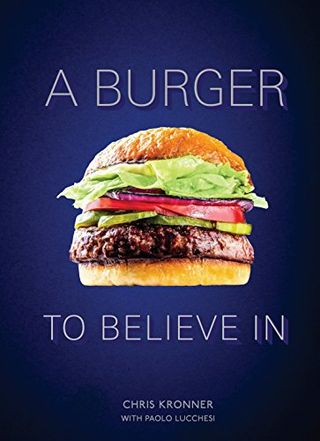A book can change your life.
For me, there have been several. In high school, The Autobiography of Malcolm X shook my view of race while Johnny Got His Gun and Catch-22 shifted my perspective of war. In college, The Dice Man made me question control and Geek Love made me ponder family.
But it wasn’t until 2018 when a cookbook changed my life—or at least changed how I cooked in such a seismic way that the rest of my life bent around it.
That book is A Burger to Believe In by Chris Kronner.
A few months before Ten Speed Press published the book, Kronner’s restaurant, KronnerBurger, closed. I’d never been. In fact, I’d never even heard of it until I’d opened A Burger to Believe In.

And then there, on page 13, was Kronner’s ethos:
“Thoughtful reductive simplicity: A hamburger is the sum of its parts. Don’t complicate it. Start with the best parts. If the best parts aren’t available, allow the parts you have to shine by treating them thoughtfully.”
This isn’t a description for how to cook a burger, as I have now come to understand. It’s a way of life. In fact, you can replace the word “hamburger” for just about any major aspect of your life and it works. Try it: “relationship,” “job,” “self-improvement.”
Thoughtful reductive simplicity.
Kronner applies such thoughtfulness to building hamburgers that he upends almost every burger convention. He sources beef from old grass-fed dairy cows dry-aged for 30 days because they taste better. He doesn’t grind pepper onto his patties because pepper burns and tases acrid when hit with the grill’s high heat. There’s an entire section of the book that shows you how to dry-age your own beef at home using a mini-fridge and electric fan (why leave it up to the bucher?).

But perhaps the most potent piece of thoughtful reductive simplicity as it applies to a burger—and the first instance in which I felt the concept’s immediate effects—was in how Kronner approached the burger onion conundrum.
Raw onions distract from the taste of great beef. Overcooked onions slip out of the burger. So split the difference, writes Kronner, and grill only one side of an onion slice. Just cut a red onion into (roughly) ⅓-inch rings and grill for 1 minute.
I had the ultimate good fortune of speaking with Kronner this February for the version of this article that appeared in Men’s Health. (He’s now the founder of Mayday, a burger and seafood delivery market in Los Angeles.)
It was the kind of hurried conversation that I wished I could repeat in person, over a burger, to learn more from the man not just about cooking, but also about his philosophy.
Even though A Burger to Believe In specifically states that “There is no one way to cook or compose a hamburger,” I’ve tasted, in my own home cooking, the glory and wonder of what I’m sure is but a glimmer of a true Kronnerburger. And it is truly the one right way to grill a burger.
It is thoughtful, indeed. It is also simple, but only in approach.
The meal that comes afterward is a complex experience of palate- and perspective-shifting emotions, a recalibration not just of burgers, but of life—one that needs to be lived to be believed.
1. Start with better beef.
Coarsely ground, dry-aged, grass-finished chuck produces the tastiest juicy burger. Ask a butcher to grind the meat fresh (5 ounces for every burger you’ll be making).

If your butcher balks, find another butcher. No man should suffer through bland, boring beef.
2. Shape the patty.
Hand-molded patties cook unevenly and fall apart on the grill.

Line a 4-inch ring mold (or the cap of a mayo jar) with plastic wrap and gently press a portion of the ground beef into the mold until uniform. Pop the patty onto a plate and refrigerate for 30 minutes.
3. Prepare the grill.
Preheat one side of the grill to just below high or until the coals are white-hot but not aflame. Preheat the other side to medium low.

Right before grilling, season the patties liberally with salt on both sides. (We’re talking 1/2 tsp per side.) Hold the black pepper—it’ll burn on the grill and make the burger taste acrid.
4. Toast and cook.
Set a skillet over the medium-low heat. Butter white hamburger rolls and set them cut side down on the skillet for 6 to 8 minutes.

Place the patties over the higher heat and grill 2 minutes, until a crust forms. Flip and cook 1 minute for rare (or 2 or 3 more for medium rare).*
The burger and buns should finish at the same time.
5. Build.
Willy-nilly toppings placement can result in toppling and sliding. Place the patty on the bottom of the toasted bun and top in this order: dill-pickle slices, charred onions, sliced tomato, and a few leaves of crisp torn iceberg lettuce. Spread 1 Tbsp mayo on the top bun and cap it off. Serve with a tower of napkins.
*Rare burgers highlight the flavor of incredible beef. That said, the USDA recommends cooking all ground beef to a minimum of 160°F to best reduce your risk of bacteria and foodborne illness.
A version of this article appeared in the June 2021 issue of Men’s Health.
Source: Read Full Article